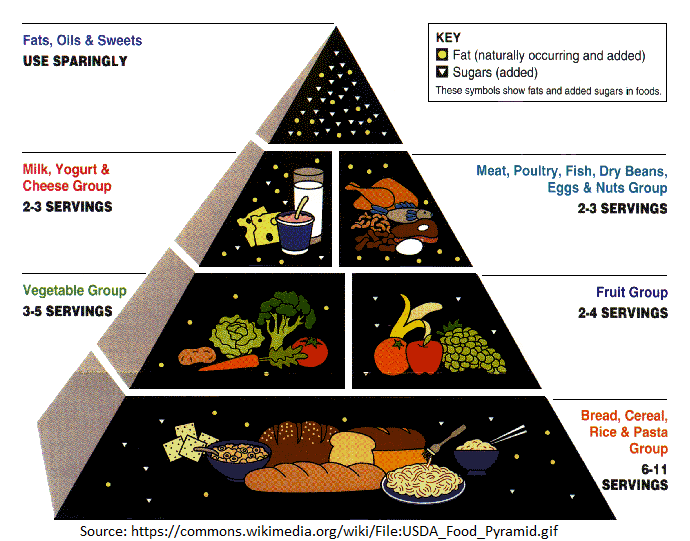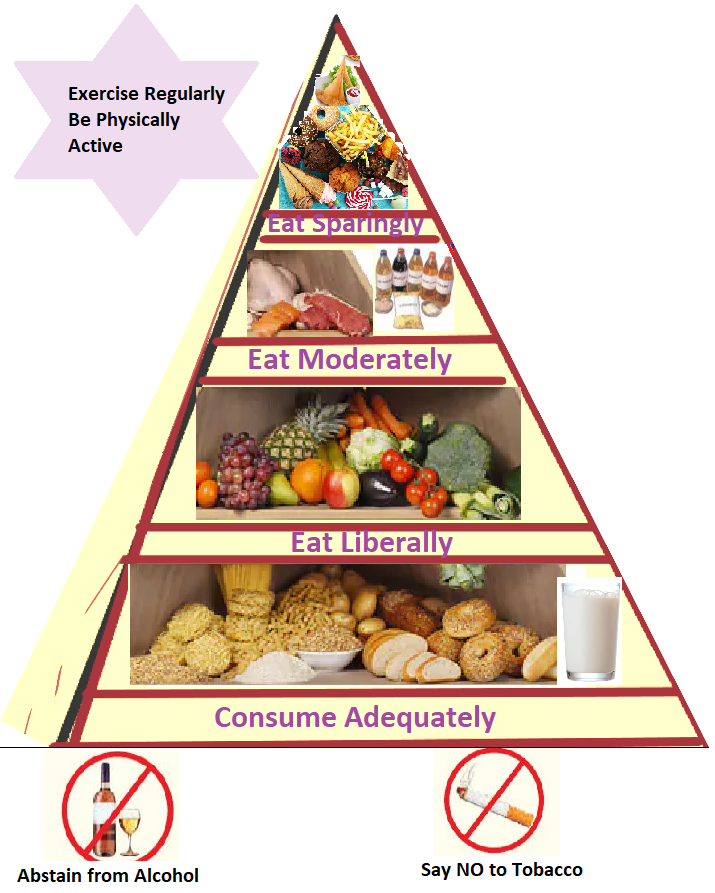The “Food Pyramid” or “Food Guide Pyramid” was introduced by the USDA (US Department of Agriculture) in 1992.
It is meant as a reference for planning a balanced diet everyday.
It defines five groups of foods:
1. breads, cereals, pasta and rice;
2. fruits and vegetables;
3. dairy products; eggs, fish, legumes,
4. meat and poultry;
5. alcohol, fats and sugars –
• Sugars mean ADDED sugar.
• Fat and sugars come mostly from the fats, oils and sweets.
• Still foods from other groups – e.g. cheese or ice-cream from the milk group or French fries from the vegetable group - can also be a source of fat and added sugars
Each of the 5 groups provides some nutrients, but NOT ALL the nutrients.
Hence, Foods from each group have to be included in the diet, one group cannot replace another.
In other words, none of these major food groups is more important than another and all the groups need to be included for a balanced diet.
The Pyramid shape signifies share of the food groups in a balanced diet.
Food groups are placed in the pyramid, in the order of share needed in a balanced diet.
Foods at the base are recommended to be consumed in higher quantity than foods at the top.
It states that “None of the food group is good or bad. It’s the bad combinations of these foods”
Indian Food Pyramid
It is developed by the National Institute of Nutrition and endorsed by the Ministry of Health.
The pyramid is divided into four levels of foods according to recommended consumption:
1. Cereals and legumes/beans at the base should be eaten in sufficient quantity,
2. Vegetables and fruits on the second level should be eaten liberally,
3. Animal source foods and oils on the third level are to be eaten moderately, and
4. Highly processed foods high in sugar and fat are at the apex and to be eaten sparingly.
Accompanying the pyramid are:
1. An advice for regular physical activity and
2. Warnings against smoking and drinking alcohol
I. Largest amount at the bottom of the pyramid includes:
1. Cereals,
2. Millets,
3. Pulses &
4. Milk
These provide most of the nutrients and these should be consumed adequately.
Milk provides good quality proteins and calcium
II. Vegetables and fruits
• Source of protective nutrients viz. vitamins/ minerals/ phytonutrients
• Should be consumed liberally.
1. Seasonal
2. Different colored &
3. Fresh fruits and vegetables are recommended
III. Oils and meat products should be consumed in moderate amounts
• Oils and nuts are calorie-dense: for increase the energy density and quality of food
• Meat and meat products contain
– Good quality protein and
– Iron.
• Vegetarians can obtain most of the nutrients from a prudent combination of cereals, pulses, vegetables, fruits and milk.
IV. Last of all, foods high in fat, salt & sugar (HFSS) k/a ‘Junk Foods’ should be consumed sparingly.
• Includes burger, French fries, ice-cream, colas, chocolates etc.
• Bakery items are also included in this category
References:
1. Park’s Textbook of PSM. 25th ed. 2019 Bhanot Publishers, Jabalpur
2. Stanford Health Care website. Available at: https://stanfordhealthcare.org/medical-clinics/cancer-nutrition-services..., accessed on 30th March 2021 at 1:25 PM
3. Eat Right India, Fassai, GOI. Available at: https://eatrightindia.gov.in/eatright-toolkit-english.jsp, accessed on 30th March 2021 at 1:25 PM
